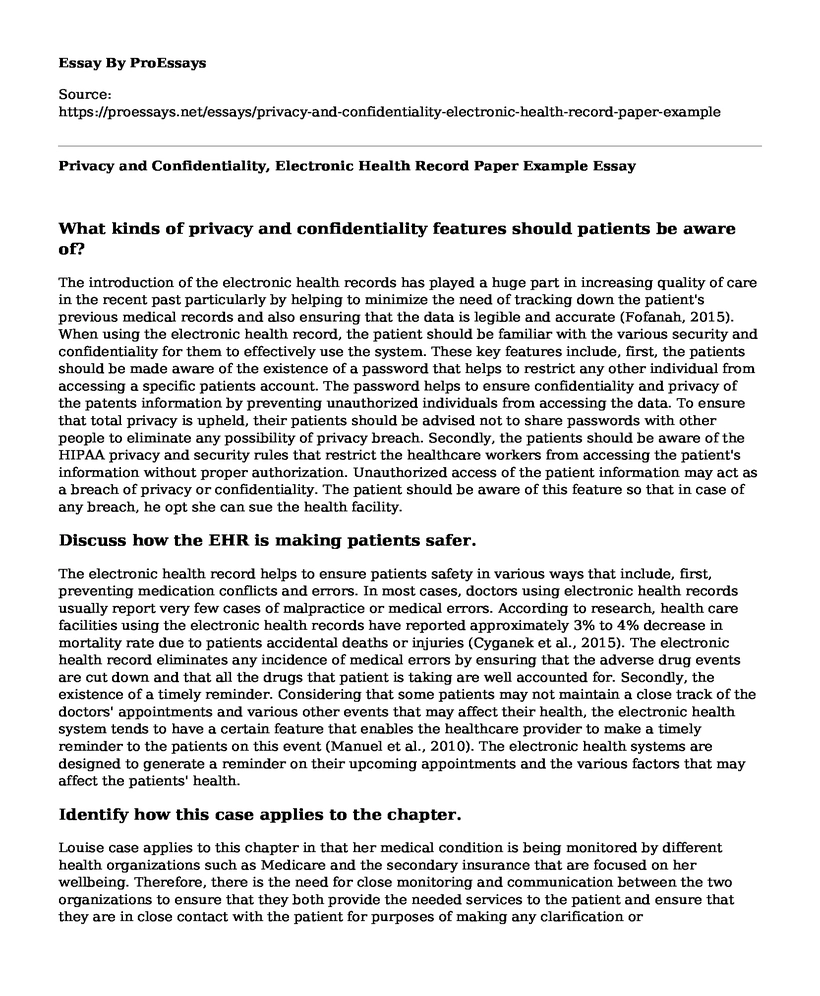What kinds of privacy and confidentiality features should patients be aware of?
The introduction of the electronic health records has played a huge part in increasing quality of care in the recent past particularly by helping to minimize the need of tracking down the patient's previous medical records and also ensuring that the data is legible and accurate (Fofanah, 2015). When using the electronic health record, the patient should be familiar with the various security and confidentiality for them to effectively use the system. These key features include, first, the patients should be made aware of the existence of a password that helps to restrict any other individual from accessing a specific patients account. The password helps to ensure confidentiality and privacy of the patents information by preventing unauthorized individuals from accessing the data. To ensure that total privacy is upheld, their patients should be advised not to share passwords with other people to eliminate any possibility of privacy breach. Secondly, the patients should be aware of the HIPAA privacy and security rules that restrict the healthcare workers from accessing the patient's information without proper authorization. Unauthorized access of the patient information may act as a breach of privacy or confidentiality. The patient should be aware of this feature so that in case of any breach, he opt she can sue the health facility.
Discuss how the EHR is making patients safer.
The electronic health record helps to ensure patients safety in various ways that include, first, preventing medication conflicts and errors. In most cases, doctors using electronic health records usually report very few cases of malpractice or medical errors. According to research, health care facilities using the electronic health records have reported approximately 3% to 4% decrease in mortality rate due to patients accidental deaths or injuries (Cyganek et al., 2015). The electronic health record eliminates any incidence of medical errors by ensuring that the adverse drug events are cut down and that all the drugs that patient is taking are well accounted for. Secondly, the existence of a timely reminder. Considering that some patients may not maintain a close track of the doctors' appointments and various other events that may affect their health, the electronic health system tends to have a certain feature that enables the healthcare provider to make a timely reminder to the patients on this event (Manuel et al., 2010). The electronic health systems are designed to generate a reminder on their upcoming appointments and the various factors that may affect the patients' health.
Identify how this case applies to the chapter.
Louise case applies to this chapter in that her medical condition is being monitored by different health organizations such as Medicare and the secondary insurance that are focused on her wellbeing. Therefore, there is the need for close monitoring and communication between the two organizations to ensure that they both provide the needed services to the patient and ensure that they are in close contact with the patient for purposes of making any clarification or recommendation. The two organization n should also be in contact with the home health agency to for purposing of updating the progress and the needed payments.
What could the home health agency have done to prevent this problem?
To eliminate the existing payment problem, the home health organization should set up an electronic health system that will ease the sharing of information between the health care agencies and the patient. This would have helped the patient and the home health agency to monitor the account issues by ensuring that both the Medicare and the secondary insurance company had billed the patient. This would have eliminated any possibility of confusion or errors when charging the patient. The home agency would also have been to make a close follow-up with the Medicare and secondary agency to ensure that all the payment requirements have been met.
References
Cyganek, B., Grana, M., Kasprzak, A., Walkowiak, K., & Wozniak, M. (2015). Selected aspects of electronic health record analysis from the big data perspective. In Bioinformatics and Biomedicine (BIBM), 2015 IEEE International Conference on (pp. 1391-1396). IEEE.
Fofanah-Sesay, N. S. (2015). Development of an Electronic Health Record Educational Project for Staff Nurses (Doctoral dissertation, Walden University).
Manuel, D. G., Rosella, L. C., & Stukel, T. A. (2010). Importance of accurately identifying the disease in studies using electronic health records. BMJ, 341, c4226.
Cite this page
Privacy and Confidentiality, Electronic Health Record Paper Example. (2022, Nov 20). Retrieved from https://proessays.net/essays/privacy-and-confidentiality-electronic-health-record-paper-example
If you are the original author of this essay and no longer wish to have it published on the ProEssays website, please click below to request its removal:
- Australian Healthcare Context
- Essay on Nursing: Registered Nurse Licensed Practical and Licensed Vocational Nurses
- Responses on Nursing Profession and Social Work
- Miss Jose's Health Condition Paper Example
- Essay Sample on Atradius Organizational and Management Philosophy Adaptation
- Age & Healthcare Providers: Understanding Interactions - Essay Sample
- Strategic Training: Key to Instilling Healthcare Policies and Procedures - Report Sample







